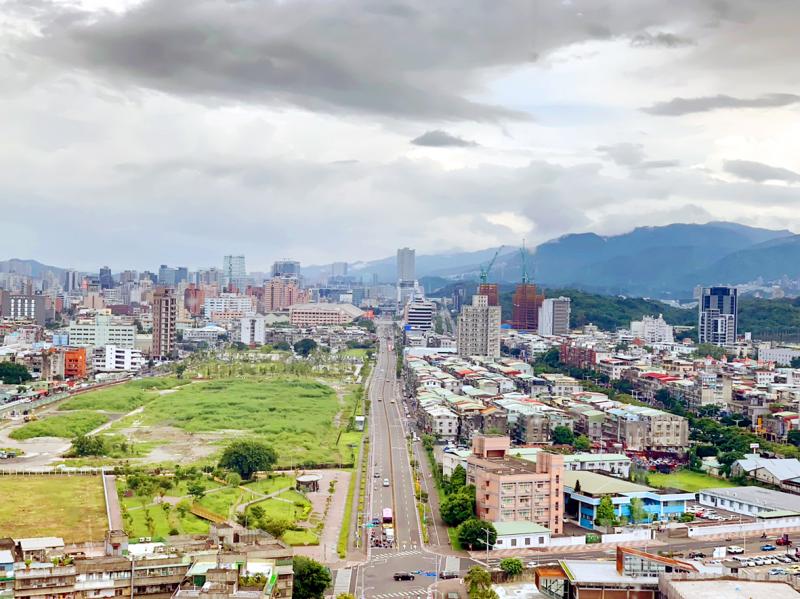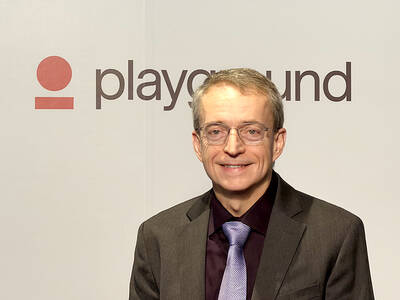Demand for plant construction is likely to be sustained for years, and is expected to benefit building material and construction companies, as well as some financial firms, Yuanta Securities Investment Consulting Co (元大投顧) said.
There has been stable growth in construction loans, as purchases of land and commercial buildings have been robust since last year.
Based on data released by the central bank on Oct. 26, construction loans grew for an 18th straight month in September to a record NT$2.323 trillion (US$80.4 billion), and rose 16.09 percent from NT$2.001 trillion a year earlier.

Photo: CNA
PROOF OF DEMAND
The annual growth in construction loans in September was higher than the annual increase of 7.65 percent in housing loans for the same month and an indication of solid demand for plant construction, Yuanta analyst Lisa Chen (陳玫芬) said in a note on Thursday.
“The phase one and phase two construction projects in the Southern Taiwan Science Park (南部科學園區) have taken up 95 percent of the park’s land, with Taiwan Semiconductor Manufacturing Co (TSMC, 台積電) accounting for more than 50 percent of that and more new construction projects planned in the next five years,” Chen said.
To rapidly expand its capacity, TSMC this year has spent nearly NT$10.01 billion purchasing manufacturing facilities in Tainan from E-Ton Solar Co (益通光能), Optimax Technology Corp (力特光電), Gudeng Precision Industrial Co (家登) and HannStar Corp (瀚宇彩晶), the company has said in regulatory filings.
DUTCH INTEREST
As semiconductor plants in the science park have reached a significant scale, Dutch semiconductor equipment maker ASML Holding NV has set up an office there with 2,800 employees, Chen said.
The park has obtained government approval to launch its phase three expansion project, in which it plans to acquire 92 hectares of land by 2023 to cope with the boom in plant construction and demand from returning Taiwanese businesses, she added.
BENEFICIARIES
“As these projects are for Taiwanese companies, they are driving demand for construction materials, as well as benefiting employment and housing demand in southern Taiwan. Relocation of plants back to Taiwan from China will continue to boost construction material demand even after 2021,” she said.
Construction material suppliers and construction companies, including Goldsun Building Materials Co (國產建材實業), Tung Ho Steel Enterprise Corp (東和鋼鐵), Universal Cement Corp (環球水泥) and Da Cin Construction Co (達欣工程), would likely benefit from the demand for plant construction, Yuanta said.
Goldsun leads Taiwan’s ready-mixed concrete market with a market share of 17 percent; Tung Ho is the nation’s leading rebar and section steel supplier; Universal Cement is a major ready-mixed concrete manufacturer in southern Taiwan and a national leader in gypsum board manufacturing; and Da Cin’s business mainly focuses on plant construction, with TSMC’s orders accounting for 40 percent of its revenue from this year to 2022, the investment consultancy said.
Meanwhile, rising housing and construction loans should be positive for financial firms such as Taiwan Cooperative Financial Holding Co (合庫金控) and First Financial Holding Co (第一金控), as these two state-run companies have more exposure to this area of business than their peers, Yuanta said.

JITTERS: Nexperia has a 20 percent market share for chips powering simpler features such as window controls, and changing supply chains could take years European carmakers are looking into ways to scratch components made with parts from China, spooked by deepening geopolitical spats playing out through chipmaker Nexperia BV and Beijing’s export controls on rare earths. To protect operations from trade ructions, several automakers are pushing major suppliers to find permanent alternatives to Chinese semiconductors, people familiar with the matter said. The industry is considering broader changes to its supply chain to adapt to shifting geopolitics, Europe’s main suppliers lobby CLEPA head Matthias Zink said. “We had some indications already — questions like: ‘How can you supply me without this dependency on China?’” Zink, who also

The number of Taiwanese working in the US rose to a record high of 137,000 last year, driven largely by Taiwan Semiconductor Manufacturing Co’s (TSMC, 台積電) rapid overseas expansion, according to government data released yesterday. A total of 666,000 Taiwanese nationals were employed abroad last year, an increase of 45,000 from 2023 and the highest level since the COVID-19 pandemic, data from the Directorate-General of Budget, Accounting and Statistics (DGBAS) showed. Overseas employment had steadily increased between 2009 and 2019, peaking at 739,000, before plunging to 319,000 in 2021 amid US-China trade tensions, global supply chain shifts, reshoring by Taiwanese companies and

Taiwan Semiconductor Manufacturing Co (TSMC, 台積電) received about NT$147 billion (US$4.71 billion) in subsidies from the US, Japanese, German and Chinese governments over the past two years for its global expansion. Financial data compiled by the world’s largest contract chipmaker showed the company secured NT$4.77 billion in subsidies from the governments in the third quarter, bringing the total for the first three quarters of the year to about NT$71.9 billion. Along with the NT$75.16 billion in financial aid TSMC received last year, the chipmaker obtained NT$147 billion in subsidies in almost two years, the data showed. The subsidies received by its subsidiaries —

OUTLOOK: Pat Gelsinger said he did not expect the heavy AI infrastructure investments by the major cloud service providers to cause an AI bubble to burst soon Building a resilient energy supply chain is crucial for Taiwan to develop artificial intelligence (AI) technology and grow its economy, former Intel Corp chief executive officer Pat Gelsinger said yesterday. Gelsinger, now a general partner at the US venture capital firm Playground Global LLC, was asked at a news conference in Taipei about his views on Taiwan’s hardware development and growing concern over an AI bubble. “Today, the greatest issue in Taiwan isn’t even in the software or in architecture. It is energy,” Gelsinger said. “You are not in the position to have a resilient energy supply chain, and that,